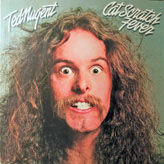The Secrets Behind Ted Nugent's "Cat Scratch Fever" Guitar Tone
Ted Nugent was one of the hardest-rocking guitarists of the late Seventies, but many players today would be surprised by the unconventional gear that he used in the studio to create his characteristic heavier-than-heavy sounds. His main weapon of choice both onstage and in the studio back then was (and still is today) an archtop thinline hollowbody Gibson Byrdland guitar from the early Sixties, which was originally designed by hillbilly jazz guitarists Billy Byrd and Hank Garland.

In addition to its slim body depth and fully hollow design, the Byrdland’s other main distinguishing features are its 23 1/2–inch scale length and narrow neck width. Nugent prefers circa 1961–’68 Byrdlands, which feature a sharp “Florentine” cutaway and a pair of humbucking pickups.
Nugent’s studio rig for “Cat Scratch Fever” was about as simple as it gets: a 1962 Gibson Byrdland and a 1962 Fender Deluxe 6G3 combo amp. Produced for a very brief period from 1961 until 1963 and easily identifiable thanks to its brown Tolex covering, the 6G3 Deluxe is beloved by tone connoisseurs for its overdrive crunch and growling midrange, which sound more like a Marshall than any other vintage Fender amp (although since the brown Deluxe pre-dated Marshall by about a year, perhaps it’s more accurate to say that Marshall amps sound more like a brown Deluxe).
Nugent was well known for performing at excessive volume levels onstage, but in the studio he made this combo—with a single 12-inch speaker—sound like he was ripping the roof off of the recording studio.

Although the Byrdland’s medium-output PAF humbucking pickups and the Deluxe’s moderate gain seem tame by today’s standards, Nugent made this modest rig sound larger than life thanks to an abundance of overdubbed unison layers for the main riff, rhythm parts panned to separate locations and tight harmonized parts for the fills and solos. The Deluxe’s thick, luscious midrange allows the guitar to remain prominent in the mix, with the bass and the drums adding body and depth.
ORIGINAL GEAR
GUITAR: Gibson Byrdland with PAF humbucking pickups (bridge pickup), volume and tone controls at 10
AMP: 1962 Fender 6G3 Deluxe with Oxford 12K5 12-inch speaker (Bright channel input 1, Volume: 10, Tone: 10, Tremolo off Speed: 0, Intensity: 0)
EFFECTS: None
STRINGS/TUNING: Dean Markley Nickel Steel Regular .010, .013, .017, .026, .036, .046/Standard
All the latest guitar news, interviews, lessons, reviews, deals and more, direct to your inbox!

- Guild Starfire III
- Seymour Duncan Seth Lover bridge humbucker
- Blackstar Artisan 15
TONE TIP: The Gibson Byrdland and Fender Deluxe 6G3 are both extremely idiosyncratic items and therefore hard to duplicate. The thinline hollowbody Guild Starfire III has midrange honk that comes close enough to the Byrdland with a PAF-style humbucker installed. The Blackstar Artisan has a similarly simple control configuration to the brown Deluxe: use channel 2 but with less gain/volume and the tone control dialed down for less brilliant treble.
Chris is the co-author of Eruption - Conversations with Eddie Van Halen. He is a 40-year music industry veteran who started at Boardwalk Entertainment (Joan Jett, Night Ranger) and Roland US before becoming a guitar journalist in 1991. He has interviewed more than 600 artists, written more than 1,400 product reviews and contributed to Jeff Beck’s Beck 01: Hot Rods and Rock & Roll and Eric Clapton’s Six String Stories.

